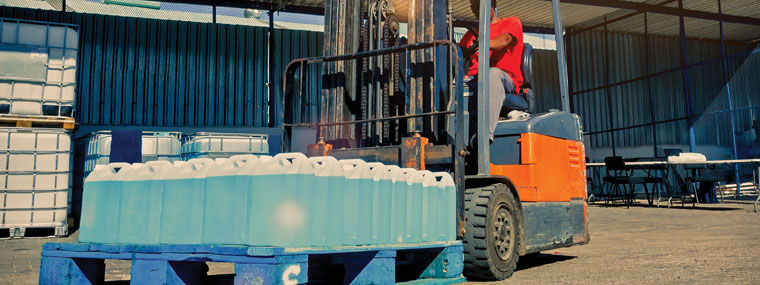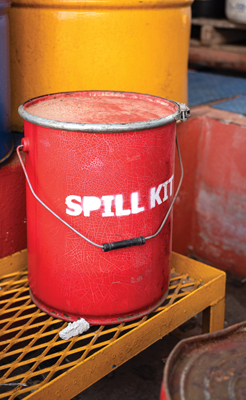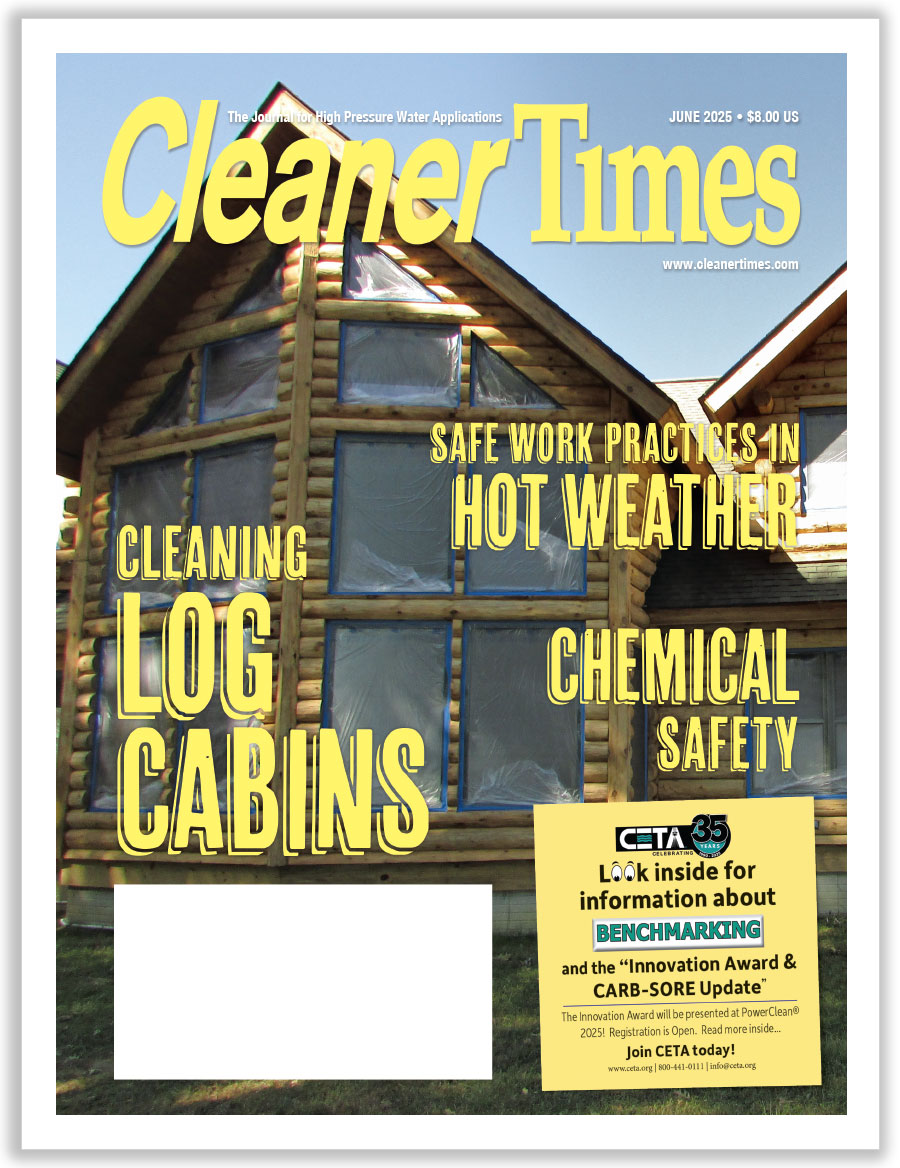
Thoughtful Engagement—Correctly Using Chemicals
By Diane M. Calabrese / Published February 2023

To grab a familiar label and start a task without double-checking it is to take a big risk and invite trouble. Thoughtful engagement is important to safety in the workplace. It applies to tools of every sort, including chemicals. Contractors, distributors, and manufacturers all share responsibility for getting it right. They should get it right the first time.
“Inform and teach technicians about the safety factors that should be addressed when using the specific chemical involved in a particular project because chemicals and their strength will vary from job to job,” says Ken J. Bolsch, owner of Green Earth Powerwash in West Palm Beach, FL. “Then, supervision is a must when the job is in progress…”
Monitoring what team members are doing—making certain they conduct self-checks—is crucial to correct use. During the cleaning process, changes may occur in conditions that require a change of approach, explains Bolsch.
Situational awareness prevents any small error from growing into a large problem. “Mistakes do happen, but if caught soon enough, little to no problem will be encountered,” says Bolsch.
By taking advantage of technical assistance manufacturers offer, distributors can make the information they provide to contractors well rounded, and contractors can enhance the capabilities of team members.
“Having hands-on training with the manufacturer of the product to see best installation practices is highly encouraged,” says Missy Ordiway, the business development manager with Deco Products Inc. in Denver, CO. “When the manufacturer offers it for free, it’s there for your growth and success, so it should be taken advantage of.”
Beyond the training, stay apprised of changes. “Keep open communication with the manufacturer and the reps to ensure you are aware of any and all chemical revisions,” says Ordiway.
Never overlook the basics. “Always have product technical data sheets, safety data sheets, and installation instructions available to each team member,” says Ordiway.
Correct use of chemicals is a fundamental part of safe workplace practices. And safety is part of the tripod that supports a company.
“Just like quality and productivity, safety is the third leg of the stool that supports long-term sustainable, growing business,” says Mike Gruver, general manager and chemist at Hydrus Detergents in Estherville, IA. In the context of that perspective, continuous improvement applies to safety as well as the other two legs.
How can a company be certain that every team member knows how to use chemicals correctly? There are two components that work side by side.
“Do we have a continuous improvement culture where people are empowered to keep learning and ask questions when faced with uncertainty?” is the first question to answer, says Gruver. The second question concerns the follow-through.
“Are the correct checks and balances in place so that the chemical is associated with the correctly trained personnel?” must be answered affirmatively, says Gruver. “Many times, people are in a hurry and don’t align skills and training with the correct personnel for the job.”
Train, align, and tap the excellent resources available for training in chemical safety. “DuPont’s safety program set the stage for a standard in excellence in the early 2000s,” says Gruver. “Now, with apps and online software, there are many programs that are available.”
A business can choose a training program that is quite closely tailored to its needs. “The opportunity is there to choose a company that can grow with your increasing training demands and cover multiple areas of needed training,” explains Gruver.
Gruver says there are some questions to ask of trainers to make a good match. “Are they flexible, adaptable, and growing?”
A company must keep pace with the steady flow of changes in regulations surrounding chemical use. It’s not easy, but it is doable.
“Be a student of your profession,” says Gruver. “Easier said than done, but set up appointments on your calendar to take time to read professional journals or e-newsletters. Subscribe. Learning one thing from five emails may just improve your operation.”
Doing it all in-house may be a cost saver, but there are economical ways to get expert help. “Don’t be afraid to use outside sources,” says Gruver.
“Find that state university with a safety program,” explains Gruver, and make use of its offerings. “You can always get an intern for a semester to help as well with tracking regulatory updates and the like,” he says.
Serious Stakes
Laugh lines aplenty have been built on the premise that a representative of the government is “here to help.” But in the realm of safety, there is no question that with the steady stream of regulations that are coupled with tools to assist implementation, the promise of help is genuine.
In a time when most students graduate from high school without having taken a chemistry course, the challenge to members of our industry in training employees in chemical use is serious. Respect for chemicals is the first thing a basic course teaches.
There’s nothing like seeing sodium react with air to bring a teen to attention. And it might get them to think twice about mixing bleach (12.5 percent sodium hypochlorite solution) with ammonia, which happened alarmingly often during the sanitizing frenzy of 2020–2021.
The safety data sheets (SDSs) required by the OSHA [Occupational Safety and Health Administration] HCS [Hazard Communication Standard] aim at one level to instill readiness for response to an incident. But they also speak to the need for respect for chemicals.
The HCS, which now aligns with the GHS [Globally Harmonized System of Classification and Labeling of Chemicals], requires new SDSs to be uniform in format with enumerated categories being consistent from compound to compound. Manufacturers, distributors, and importers must provide SDSs with their products. Contractors must have SDSs available for their employees.
There are 16 SDS categories (sections); number 16 is “other.” Number one is the identifier, which includes manufacturer or distributor name, address, phone number, emergency phone number, recommended use, and restrictions on use.
Yes, that’s just number one. It’s a critical entry, which emphasizes the product cradle-to-grave responsibility that the maker/seller has. (That maker/seller liability is enforced by the who-to-call in emergency for answers not on the label.)
SDS entries encompass seemingly everything from composition of compound to first-aid, fire-fighting measures, and handling and storage. The first 11 entries are under the purview of OSHA. Entries 12 to 15 are in the realm of other regulators, for example, “ecological information” (number 12).
Section eight of the HCS details the characteristics of the chemical in terms of personal protective equipment (PPE) required when using it and exposure controls. The exposure controls are something contractors in particular ought to look at closely. For example, OSHA sets permissible exposure limits (PELs), some of which vary with ambient conditions. (On a hot day, volatile compounds may reach a PEL faster than on a cold day.)
OSHA has been moving toward annotated tables to more accurately define PEL. In doing so, it collaborates with the state of California OSHA (Cal/OSHA) as well as private entities such as ACGIH®. There’s a great deal to digest regarding the setting of and compliance with PEL. In short, it’s another reason to set up a mechanism for receiving the latest information about expectations and for contractors to work with reliable, knowledgeable distributors who are fully engaged with manufacturers.
The advent of the HCS also introduced the requirement that manufacturers (and importers) provide a label that includes a harmonized signal word, pictogram, and hazard statement for each hazard class and category. It’s the responsibility of the employer to train employees in label elements in addition to SDSs.
Training provided by employers in the correct use of chemicals must be provided in the language the employee understands, and it must be provided at a reading level (in a vocabulary) the employee understands.
In conjunction with OSHA, NIOSH [National Institute for Occupational Safety and Health] at CDC issues “guidance” documents that amplify many requirements of OSHA and put the requirements in a more detailed context of why they matter. The OSHA-NIOSH info-sheet “Protecting Workers Who Use Chemical Cleaners,” which can be found at OSHA.gov, gives an employer good grounding in why team members must be trained.
Where to begin when training workers in correct chemical use? Never mix chemicals or use them for personal washing, and know how to dilute them.
Mixing cleaning chemicals (e.g., bleach and ammonia) can lead to the release of dangerous gases. Although using a little bleach to wash off a soiled hand might seem inconsequential, the residual effects of bleach on the skin and its absorption are cumulative.
More is not better. It is just more and is often dangerous, especially where chemicals are concerned. Team members must know how to dilute chemicals. It cannot be an approximation. It must be exact.
The stakes are high and serious when chemicals are being used. Verification, by routine checks, that employees are following correct procedures must be done. It’s not just about compliance with regulations. It’s about ensuring that risk is minimized in every possible way.
Chemicals make our world an amazing place. Be awed by their power and all they make possible, but take all necessary care in use.






